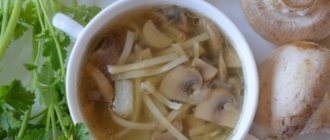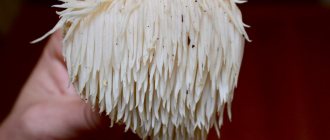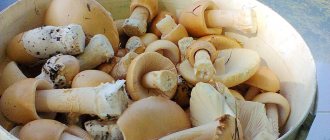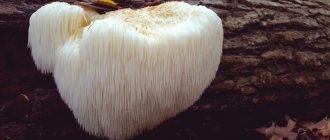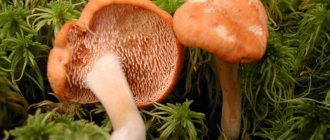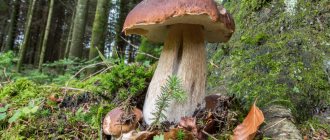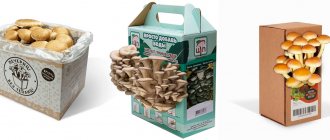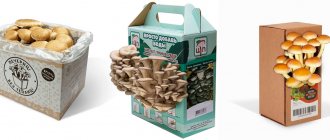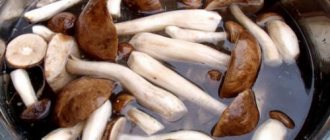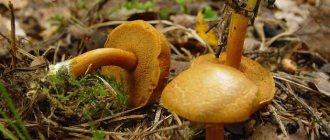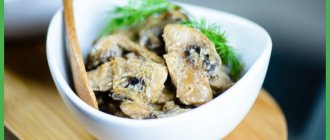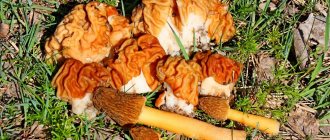Have you ever tried mushrooms that look like a lion's mane? Surprised? However, this type of mushroom promotes brain function, has anti-cancer properties and many other benefits.
Blackberry is a nootropic product that is often used in Traditional Chinese Medicine. Several years ago, a large study was conducted to study the effect of the mushroom on brain function. The results were amazing.
One study published in the Journal of Agricultural and Food Chemistry noted that blackberry has "antibiotic, anticarcinogenic, antidiabetic, antihypertensive, antiaging, cardioprotective, neuroprotective, antianxiety properties, and improves cognitive function."
Spreading
This is a very rare mushroom - its numbers are rapidly falling every year. This is due to environmental pollution, large-scale deforestation and unwise collection by people. Today, the combed hedgehog is on the verge of extinction, and therefore it is listed in the Red Book.
In its natural environment, the mushroom can be found in North America, Russia and China. In particular, it prefers zones with a temperate, warm climate. For example, if we talk about our Motherland, then the “lion’s head” can be seen in the Primorsky Territory, Amur Region, Crimea, as well as in the deciduous forests of Khabarovsk.
Features of growing mushrooms yourself
Despite their edibility and health benefits, collecting comb blackberries is not recommended due to their inclusion in the Red Book.
You can grow comb blackberries yourself. To do this, you need to buy a substrate, which consists of plant elements and tree species. The optimal composition is corn flour (20%) and beech sawdust (80%).
In order to grow combed blackberries at home, you need:
In the first month of growth, the mushroom does not need sunlight. Then, when the primordia of fruiting bodies appear, lighting will be required. The mushroom bears fruit in waves, and the first two periods are considered to be the most productive.
In order for the mycelium to become overgrown, it will take up to six months. It is necessary to place it in a shady garden or room that is regularly ventilated. The optimal temperature is from 7 to 27 degrees.
Harvesting is carried out up to 2 times in the spring and up to 2 times in the fall.
Appearance
For those who want to understand what the bearded mushroom looks like, a photo is the best option. After all, without it it is quite difficult to recreate a verbal image that even remotely resembles the amazing appearance of a mushroom. Still, if you decide to do this, it is best to imagine a white hedgehog or a mountain of noodles attached to a tree trunk. Agree, this is a rather unusual picture.
If we talk about size, the combed hedgehog grows on average to 20-25 cm in diameter. Moreover, its white “needles” processes can reach 6-8 cm in length. This miracle weighs about 1-1.5 kg, which is quite impressive. However, such standards apply only to wild-growing specimens—a farmed bearded mushroom can be much larger in size and weight.
The body of the combed hedgehog is dense. Inside, the pulp is white or cream-colored, without any impurities. And only at the end of its life, when the mushroom begins to dry out, it acquires yellow tones.
Similarities with other mushrooms
Yellow bramble is the wild card in the mushroom family, and for anyone trying to figure out the identification of edible mushrooms, its failure to conform to even the most basic mycological norms makes it unique and easily recognizable.
Moreover, it is quite common, immune to insect attack and very nutritious in taste. Yellow hedgehogs are closely related to chanterelles, and their scent is strikingly similar. For many years, mycologists have suspected a connection between Hydnum repandum (sometimes called Dentinum repandum) and chanterelles. In fact, the hedgehog mushroom is easy to mistake for a faded chanterelle—until you look at its spiny underside.
Among the twin mushrooms are the white hedgehog (Hydnum albidum) and the giant hedgehog (Hydnum albomagnum). The white hedgehog has a white to pale yellowish-gray fruit body with yellow to orange bruises. The giant hedgehog is larger and paler than the yellow hedgehog. The white hedgehog is smaller, with caps 3–5 cm in diameter and thinner stems 0.5–1 cm wide. Its caps sometimes have a hole in the center of the cap, in contrast to the flat or slightly depressed caps of the yellow hedgehog. Microscopically, the former has spores that are larger and more elliptical than those of the yellow hedgehog, measuring 7.5–9 by 6–7.5 µm. The European equivalent, Hydnum rufescens, is also smaller than H. repandum and has a deeper apricot to orange color. Hydnum ellipsosporum, described as a new species from Germany, in 2004, differs from H. repandum in the shape and length of its spores, which are ellipsoidal and measure 9–11 by 6–7.5 µm. Compared to H. repandum, it has smaller fruiting bodies with caps ranging from 3 to 5 cm in diameter.
Tree bearded mushroom: habitat
Today you can meet the combed hedgehog only in remote regions. It does not tolerate any air pollution well, and therefore grows quite rarely in roadside areas. This means that everyone who wants to find him must get used to the idea that the hunt may drag on for several days. True, many are ready to make such a sacrifice just to see how the bearded mushroom grows. A photo of this handsome man is truly a glorious reward, proving the tenacity and perseverance of any naturalist.
So where to look for it? Deciduous forests located away from the city and major highways are best suited. In this case, you should look for areas with high humidity, since the hedgehog does not tolerate drought well. For example, you can search areas around ponds, rivers, lakes or swamps.
As for trees, in our region the bearded mushroom most often grows on oak, beech or birch, and it likes the latter the most. “Lion's head” is indiscriminate in wood, and therefore can germinate both on a healthy trunk and on a rotten one. Most often, only one mushroom lives on a tree, but there are exceptions.
Coral blackberry: photos and similar species
Family: Hericiaceae.
Synonyms: coral mushroom, hericium coral-shaped, blackberry lattice-shaped.
Description. This blackberry has branched out its cap so much that it has become shaped like a cattail. The entire mushroom is bushy, coral-branched, white, sometimes with a yellowish or pinkish-flesh tint, and grows up to 30 cm in diameter.
Pay attention to the photo of coral blackberry: it has long, 1-2 cm, thin, rather brittle thorns. The pulp is white, fibrous, elastic, slightly yellowish with age, with a pleasant taste and smell.
The pulp is white, fibrous, elastic, slightly yellowish with age, with a pleasant taste and smell.
It is found throughout the forest zone of Russia, except for the northern part. Inhabits forests of various types, appearing on dead trunks, branches, and in the hollows of living deciduous trees. In the southern regions it prefers elm, oak and linden, in temperate forests - mainly birch and aspen. Fruits in June-October.
Similar species. A closely related species is the very rare alpine blackberry (H. alpestre), which differs primarily in its woody substrate. This similar species of coral-shaped blackberry grows on stumps, large dead wood and dead trees of spruce, fir and cedar pine in mountain, less often lowland taiga forests.
Medicinal properties: In 1998, German researchers isolated erinacin E from the fermentation broth of H. coralloides. This molecule turned out to be a highly selective agonist for opioid receptors in the nervous system. Erinacin E turned out to be a powerful stimulator of nerve growth factor synthesis, which immediately made it a potential drug for the treatment of Alzheimer's disease. In 2008, Japanese scientists managed to synthesize erinacin E purely chemically. Currently, a medical drug based on it is being developed.
In addition, the antiparasitic activity of the fungus is shown. A mixture of fatty acids from a mycelial culture of H. coralloides was toxic to the nematode Caenorhabditis elegans.
Chinese researchers believe that the medicinal properties of coral blackberry are in no way inferior to those of another world-famous medicinal blackberry - comb blackberry.
Use in cooking: Edible, does not require preliminary boiling. Used for frying, preparing soups, fillings, drying.
Gourmet dish
Mushroom noodles are very popular in the culinary world. The reason for this is its unusual shape and excellent taste. Some gourmets claim that the flesh of the mushroom tastes somewhat like shrimp. Agree, many will like this delicacy, especially considering the fact that this is a dietary food.
It is not surprising that combed hedgehog is on the menu of many prestigious restaurants. At the same time, it is served both after heat treatment and raw. The only downside is the high price of such a dish. But for those who love new tastes and sensations, this is not such a huge obstacle.
Dosage
Dietary supplements with crested manger are often used to strengthen the immune system and support cognitive function. They can be seen in extract, powder, capsule form and can be purchased online or at a pharmacy.
In capsules, blackberry may be the only ingredient or part of a complex aimed at improving brain function. In this case, it may include nootropic products such as reishi, cordyceps, ginkgo biloba and ashwagandha.
Before using a dietary supplement, read the instructions carefully and take only the recommended dose. It usually varies in volume from 300 to 3,000 mg 1-3 times a day. To avoid an unwanted reaction from the body, start taking it with a small dosage and gradually increase it.
If you experience an allergic reaction (itching, indigestion, rash), stop taking the drug immediately.
Healing properties
In China, healers have long used bearded mushroom in their practices. The beneficial properties of this vegetable “hedgehog” are well known to them. In particular, it was they who told the world that the hedgehog can help a person with sclerosis. This knowledge also helped pharmacists produce the medicine needed to treat patients suffering from Alzheimer's disease.
In addition, the mushroom has an anti-inflammatory effect. In Russia, healers used it to treat stomach diseases and tumors. There is also evidence that bearded mushroom extract is used in research to find a cure for cancer.
Other options for cooking your favorite product
The instructions on how to cook fried mushrooms are characterized by extremely simple rules. First, you should rinse each mushroom and clean it (remove the remaining mycelium from the end of the legs). A dry frying pan should be greased with vegetable oil and heated on the stove. Next, you need to cut the blackberries into pieces of approximately the same size and pour them into a hot frying pan. Mushrooms should be cooked over low heat on the stove; in the middle of the frying process, you will need to add finely chopped onions and bring the dish to readiness.
Blackberry mushrooms are fried with the addition of chopped onions
Source
Built environment
As mentioned earlier, the combed hedgehog is listed in the Red Book. This means that harvesting this mushroom in natural conditions is strictly prohibited. Therefore, today special farms are opening all over the world where the bearded mushroom is grown under artificial conditions. This is a rather complex process, but modern farmers have succeeded well in it - domestic mushrooms not only have the same properties as wild ones, but are also significantly larger in size.
The only problem remains the Asian healers. According to their beliefs, only forest mushrooms have magical Qi energy. That is why in these parts, even today, there is a tireless struggle for natural treasures. Unfortunately, this could lead to the complete extinction of the species within their region.
fb.ru
Use in cooking
Most often in cooking, cherries are salted, pickled or dried. However, the “culinary life” of mushrooms is not limited to this. It is irreplaceable in soups, broths and sauces. It will add a subtle and delicate aroma to any dish. Cherry mushroom is excellent for stewing - the fleshy pulp boils down a little during cooking, which is a very valuable quality of mushrooms.
In cooking, hanging fruits are used both for preparing multi-component dishes and as an independent snack. These mushrooms are suitable for boiling, frying and baking, but pickling may cause problems. Cherry is not suitable for pickling and pickling, since its structure is quite delicate, so you risk getting a container of thick mush instead of a jar of delicious mushrooms.
We suggest you read: How to plant mushrooms on the plot
To prepare dishes with mushrooms, young hanging mushrooms are usually used, since old ones have a very hard structure and too dense flesh, which negatively affects the taste of the dish.
Before using the mushroom for preparing certain dishes, we recommend that you familiarize yourself with the algorithm for processing this mushroom.
- To begin, place fresh cherries in a deep bowl and fill with cold water to the top, leaving the ingredients in this position for twenty minutes. During this time, leaves and other debris will fall away from the surface of the mushrooms, which will later be very easy to remove by hand.
- Clean the mushrooms from debris, then drain the dirty water and take new water, adding salt to it, based on the calculation of five grams per liter of water. The curds should be kept in the salted liquid for at least two hours, after which the water should be drained and the food should be washed using a sieve or colander.
- Place the peeled mushrooms in a saucepan and fill with clean water, placing the container on the fire. When the water boils, you should boil the cherries for at least twenty minutes, after which you should drain the liquid and cool the food.
By following this algorithm, you will be able to properly prepare the hangings for further use in cooking.
Characteristic
The blackberry comb mushroom belongs to the Hericiaceae family of the order Russula. It is quite large and can be eaten. It can be described as follows:
- the body of the mushroom is irregularly shaped, often pear-shaped or spherical, slightly flattened on the sides;
- adult blackberries are dark - from yellow to brown, young ones are white or cream-colored;
- the weight of one mushroom can be up to 1.5 kg;
- width – no more than 20 cm;
- as you can see in the photo, from the lower surface of the body of the blackberry comb there are many soft outgrowths hanging down, shaped like needles, their length is no more than 6 cm;
On a note! It is this part of the fruiting body of the crested blackberry - the hymenophore - that makes it very similar to a hedgehog!
- the dense pulp is whitish and does not darken even when cut, but when it dries it turns yellow;
- The taste of the pulp is compared to shrimp.
Blackberry (hedgehog) comb is a saprotroph - an organism that obtains the substances necessary for normal growth and development by destroying the body of other plants. Therefore, it can be found on stumps and tree trunks. The most preferable species for this mushroom would be beech, birch or oak. At the same time, settling on living plants, it “selects” damaged areas, for example, saw cuts and broken parts of large branches.
The blackberry comb mushroom is most common in areas with a warm and humid climate, therefore it is most often found in forests mainly in the Primorsky and Khabarovsk Territories, the Amur Region, in the Crimea, as well as in the Caucasus and northern China. As for the central and northern regions of the Russian Federation, it is extremely rare to find blackberry mushrooms in this territory.
The fruiting season begins in the last month of summer and continues until mid-autumn. However, if you manage to find a blackberry mushroom on one of the trees, then further searches can be stopped, since it usually grows “alone.”
Where to find and how to use
Unfortunately, residents of more western countries find it difficult to find combed hedgehog in stores (of course, unless you go to an oriental food store).
However, a way out can be found. First, you can grow your own mushrooms by purchasing seeds online.
Keep in mind, their taste is often compared to seafood. Mushrooms go great with brown rice or quinoa, especially if you add fresh vegetables like onions or bell peppers.
If this option does not suit you, then you can purchase blackberry in the form of a dietary supplement. When purchasing a drug, make sure of its quality.
Benefits and treatment
The medicinal properties of the blackberry comb mushroom have not yet been fully studied, however, something about its benefits is still known.
- Its extract helps fight memory impairment, including for older people.
- It is believed that the substances present in its composition, with proper therapy, can prevent cancer.
- It is used as an anti-inflammatory and wound-healing agent, as well as to get rid of warts.
- Consumption of blackberry has a positive effect on the nervous system - depression and increased excitability recede.
On a note! According to representatives of traditional medicine, blackberry preparations can correct the emotional state and alleviate the course of Parkinson's and Alzheimer's disease!
- When consumed, the concentration of cholesterol in the blood is reduced and the prevention of diseases of the vascular system is ensured.
On a note! The wild blackberry comb mushroom is now a rarity, plus, it is listed in the Red Book. It is actively cultivated in some countries, including Russia, but the product grown in this way, although affordable, is considered less healthy!
Alpine hedgehog
Hericium alpestre Pers. = N. coralloides (Fr.) SF Gray.
Family Hericiaceae – Hericiaceae
Category and status. Category 3 (R). Rare view. A relic of mountain dark coniferous forests. A promising object for biotechnology.
Short description. The fruiting body is 10-20 to 40 cm, from the very base with tree-like or coral-like branched branches, sometimes nodule-shaped at the base, hard-fleshy, hardening with age, snow-white, sometimes with a pinkish tint, turning brown with age when touched or dried , yellowing. Thorns cover the branches almost to the very base, usually on the lateral side or directed in all directions. The hyphae of the tissue of the fruiting bodies are amyloid, somewhat gelatinous, so in damp weather the branches look slightly transparent. Spores are ellipsoidal, colorless, amyloid, 3.5-5 x 3.3-4 µm.
Ecology and biology. Xylotroph or weak pathogen. Edible, single basidiomas are extremely rare, from July to August. If the coral hedgehog lives in a wide variety of places, including synanthropic ones, and prefers deciduous trees - in Europe it is beech, less often elm, oak, ash, and in the Baikal region it is birch, occasionally poplar, then the alpine hedgehog mainly affects fir in mountain undisturbed forests.
Spreading. Holarctic species - Europe, Asia, North. America. In Russia they are also distributed throughout all forest zones and are also rare. In the Irkutsk region, the coral hedgehog is recorded almost everywhere, and reliable finds of the alpine hedgehog are so far known only for the Bratsk (Mount Starukha, Kob village) and Bodaibo (Lake Oron) regions.
Limiting factors. Features of biology. First of all, obviously, poor competitiveness in the biocenosis. Near populated areas, bright and unusual fruiting bodies are, as a rule, aimlessly destroyed and are much less often used for food.
Security measures taken and required. Unfortunately, the systematic position of two closely related taxa requires clarification. Moreover, the Russian name is “coral-shaped hedgehog”, and even the Latin “N. coralloides”, which are used in the cited Red Books, in the understanding of different authors, can refer to both the rare alpine hedgehog (H. alpestre Pers.) and the coral hedgehog itself (H. clathroides (Fr.) Pers.). Therefore, we can only state that at present, in fact, both species are included in the Red Book of the RSFSR, and, accordingly, in numerous regional lists. Consequently, both species are protected in nature reserves and national parks of our country. It is certainly desirable to introduce East Siberian strains of these species into international collections of pure cultures.
Sources of information: 1 – Beglyanova, Kutafyeva, Parshina, 1978; 2 – Red Book of Krasnoyarsk. 2005; 3 – Red Book of Novosibirsk. 2008; 4 – Red Book of the RSFSR, 1988; 5 – Red Book of the USSR. 1984; b – Red Book of the Republic of Khakassia, 2002; 7 – Red Book of Ust-Ordynsky. 2006; 8 – Red Book of Chitinskaya. 2002; 9 – Nikolaeva, 1961; 10 – List of rare ones. 2000; 11 – Unique. 1990; 12 – Courtecuisse, 1994; 13 – Ginns, 1984, 1985; 14 – Julich, 1984; 15 – Imazeki, Hongo, 1998; 16 – data of the compiler. Compiled by: A.N. Petrov.
Cooking features
There is an opinion that only young blackberries can be tasty, but this assumption is wrong. A mature mushroom is also quite capable of fully revealing all its taste qualities, and the recipe for making comb blackberry does not have any complex secrets - it just needs to be boiled in salted water. After a short heat treatment, blackberries become softer, which allows them to be used in a wide variety of dishes.
Mushroom soup with melted cheese
For four servings you will need:
- blackberry mushroom – 300 g;
- chicken meat – 180 g;
- processed cheese – 200 g;
- potatoes - 3 medium tubers;
- butter - about a tablespoon;
- medium head of onion;
- salt pepper.
Pour one and a half liters of water into a saucepan and cook the chicken fillet for 20 minutes from the moment it boils, add salt. Remove the meat from the broth and cut into small cubes.
Finely chop the onion and saute it in butter for about 5 minutes. Chop the mushroom as desired, pre-boil it (if necessary) and add to the onion. Stir and adjust to taste with salt and pepper.
Return the broth to the stove and heat it up. Cut the potatoes into small cubes and add them to the broth. After a quarter of an hour, when the potatoes become soft, add the mushrooms and onions, and after another five to seven minutes add the chicken fillet.
At the end, you need to add processed cheese to the pan and mix everything thoroughly until the last ingredient is completely dissolved.
Mushrooms with vegetables in Chinese
The blackberry mushroom recipe continues with a Chinese dish that is cooked in a wok. For two servings you will need:
- blackberry mushroom – 150-170 g;
- bell pepper – 2 pcs.;
- sesame seed - teaspoon;
- sesame oil – 20-30 ml;
- soy sauce – 30 ml;
- oyster sauce - half a teaspoon;
- sugar - half a teaspoon.
Slice the mushrooms thinly and boil if necessary. Cut the pepper into thin long strips.
Advice! The dish will look more appetizing if the bell peppers are colorful!
Heat the oil thoroughly in a wok and brown the mushrooms. Add pepper and fry everything until it softens. Pour in oyster sauce, then soy sauce, add the specified amount of sugar. Mix everything thoroughly and leave for about a minute. At the end, add sesame seeds, stir again and immediately remove from the stove. Keep covered for about 10 minutes, then serve.
priroda-znaet.ru
Nutritional value and edibility of blackberry mushrooms
Despite the fact that the mushroom has a pleasant smell, not every gourmet will eat it. In terms of taste, it occupies the fourth category. For culinary purposes, only young mushrooms are used , since mature individuals begin to taste bitter. To eliminate the bitter taste, the raw materials should be boiled.
To prepare the dish, usually only the caps of the fruiting body are used. They have a mild sweetish taste and a pleasant nutty aroma. 100 grams of product contains 22 kcal.
French cuisine has many mushroom recipes for main courses, as well as mousses, juliennes, appetizers or side dishes. The powder made from dried specimens is used as a seasoning that adds a piquant taste to dishes.
Medicinal properties of blackberry
In addition to high culinary qualities, comb blackberry also has unique medicinal properties. This unusual mushroom is especially popular in oriental medicine, where it has long been used as an antiseptic and immunostimulating agent in the treatment of gastritis, stomach ulcers, and lung diseases, and also as a stimulant of the digestive system. In addition, the ability of hericium to inhibit the biological processes of aging and related disorders of the nervous system is well known. In Chinese folk medicine, extract of the fruiting body of Hericium crestum is successfully used to treat leukemia and esophageal cancer.
Modern science has not yet studied the mushroom well enough. However, studies (mainly in Japan and China) confirm the high medicinal value of comb blackberry. Back in the 60s, Japanese scientists discovered that the fungus poliosis has strong antitumor properties.
Later, numerous studies on the medicinal properties of hericium were conducted in China. As a result, it was found that poliose extracted from the culture liquid of the fungus effectively increases the activity of anti-cancer cells - macrophages and prevents a decrease in the number of leukocytes. Moreover, these properties are most effective in the treatment of leukemia and esophageal cancer. It was also found that the combined use of hericium with similar preparations from other fungi significantly increases the antitumor effect. The antitumor properties of blackberry have also been confirmed by Russian and Korean researchers.
As a result of these studies, the following active substances were found in the fruiting bodies of Hericium crested: ergosterol, beta-glucans, cyatane derivatives, erinacins and hericenones. Five (!) polysaccharides, phenols and fatty acids were isolated from substances with antitumor activity. The significant antibacterial, antifungal and immunostimulating activity of aqueous and alcoholic extracts of the fungus was confirmed. In addition, hericium has been shown to lower blood sugar levels.
Research in the field of neuralgia has revealed another interesting feature of hericium. More recently, a substance called nerve growth factor (NGF), which is a special type of protein that promotes the regeneration of brain neurons, was isolated from a mushroom in Japan. Dr. Takashi Mitsuno believes that the extract of this unique mushroom can be an effective remedy in the treatment and prevention of Alzheimer's disease, the most common form of senile dementia associated with degenerative processes in the nerve cells of the brain responsible for cognitive information. To date, there are no effective means of combating this disease; methods of prevention are not known to modern medicine. Existing medications (amiridine, tacrine, Cerebrolysin and their analogues) can only slightly inhibit the development of the disease, but none of them contribute to recovery processes.
Summarizing the above and taking into account the experience of using the mushroom in folk medicine of the East, the indications for the use of hericium comb can be reduced to the following list:
1. Leukemia and cancer of the stomach, esophagus, pancreas, and liver. It is effective both as part of complex therapy and separately when other methods are not acceptable. Increases the effectiveness of chemical and radiation therapy from 2 to 7 times, reduces side effects;
2. Benign neoplasms - polyps, cysts, adenomas, etc.;
3. Alzheimer's disease, multiple sclerosis, neuroses, insomnia, depressive states;
4. Gastritis, stomach ulcer;
5. Strengthening the immune system and maintaining homeostasis;
6. Gynecological diseases;
7. Slowing down the processes of aging and cell degeneration.
Dried mushroom powder is usually used as an active substance for preparing extracts at home.
primdikoros.ru
Interesting Facts
To summarize, it is worth additionally noting a lot of unusual, interesting information about this unique fruiting body:
- Hericium comb has such fancy names: “monkey head”, “bearded tooth” or “lion’s mane”, houtougu (Chinese analogue), yamabushitake (Japanese).
- Blackberry grows on both living and dead trees.
- When cooked, it resembles shrimp meat in color and taste.
- It is actively used in Chinese medicine for the treatment of oncology and problems with neurology.
- Traditional medicine has long used yamabushitake extract to create ointments to treat dermatological ailments.
- “Relative” of the combed hedgehog - the coral hedgehog is similar to its “brother”, but has fewer useful properties.
- Some food companies have recently launched coffee with extracts of chaga mushrooms and urchin mushrooms into the European market. It is prepared from freshly picked fruiting bodies that are dried.
If you are lucky enough to come across this miracle mushroom in the forest, do not pass it by, take advantage of this wonderful opportunity to try a delicious product or prepare an excellent medicine from it!
Information sources
- All about mushrooms / ed.-comp. Pelle Jansen. Crystal Publishing House, 2004
- Tara Hammonds Lion's Mane: A new candidate for profitable forest mushroom cultivation, April 6, 2015
Description of blackberry comb
The color of the combed blackberry can vary from light beige to cream. The mushroom has a whitish fleshy pulp, which turns yellow as it dries. The fruit body is pear-shaped or round. The shape of the mushroom is elongated, compressed at the sides. The length of the fruiting body can reach 20 centimeters. The weight of the comb blackberry reaches 1.5 kilograms.
The mushroom is similar in appearance to a hedgehog due to its hanging, slightly curved, cylindrical needles, the length of which reaches 30-50 millimeters.
Blackberry spores are comb-white and slightly warty.
Number of blackberry comb
This is a mushroom with a declining population, so it is listed in the Red Book. Crested hedgehogs are found in Khabarovsk, Primorsky Krai, Crimea, Western Siberia, Amur Region, and the Caucasus. They are also common in China and America.
Where does the blackberry grow?
These fungi settle on the trunks of dead and living plants. Most often they can be found in the cracks of oak, less often birch or beech. Comb blackberries grow from July to October.
The value of blackberry
This mushroom is an expensive delicacy - the price of a wild mushroom can reach 5 thousand dollars; therefore, artificial cultivation of blackberries is practiced.
The taste qualities of these delicious mushrooms are highly valued. The taste of the mushroom is very subtle, sweetish. The taste is reminiscent of chicken or shrimp with a pronounced mushroom aroma.
gribnikoff.ru
Inedible specimens
The blackberry mushroom has two inedible varieties. They are not very similar, but many still confuse them. Let's look at the distinctive features in the table.
| Name | Characteristic |
| Diabolical |
|
| Black | The second name is Phellodon black.
|
Description
Comb blackberry (Hericium erinaceus) belongs to the genus Hericium, family Hericium and, oddly enough, the order Russula. This edible, large, but little-known mushroom has other names: sometimes it is called lion's mane, Pom-Pom mushroom, hericium comb, grandfather's beard, mushroom noodles. Most of these names were formed among the people, since the appearance of the mushroom really resembles something shaggy, with hairs or needles. In some sources, the organism is called the combed hedgehog. But the Chinese nicknamed this species Houtougu, which translates as “monkey head.” The Japanese also came up with their own name for blackberries - yamabushitake.
- the fruiting body has an irregular pear-shaped or round shape, compressed on the sides, very large - the weight of one mushroom sometimes reaches 1.5 kg, and the width of an adult specimen is about 20 cm. The color varies from white to cream, in adult representatives - to brown or yellow ;
- Hymenophore is a distinctive feature of this species. On the lower surface, the fruiting body is covered with a huge number of long, soft, needle-like outgrowths hanging down, up to 6 cm long. This is the blackberry hymenophore, which gives the mushroom its resemblance to hedgehogs;
- The pulp is fleshy, dense, white, does not change color when damaged or cut, turning yellow when dry. Tastes like shrimp;
- The spores are white.
Mushroom farm_Comb blackberry
Blackberry (hemlock) comb is a mushroom of the Russula family. This mushroom is also called hericium. And people in different countries call these mushrooms: satyr’s beard, monkey’s head, lion’s head, air fish, Pom-pom mushroom, mushroom noodles and yamabushitake mushroom. Show in full... The Latin name of the mushroom is Hericium erinaceus.
A new tool in practical oncology
Not long ago I learned about the existence of a wonderful mushroom, it is called Hericium comb (hedgehog, blackberry, etc.). A rare mushroom listed in the Red Book, it has many healing properties, among which the prevention and treatment of malignant tumors stands out. The Chinese comrades have set up collection points in all areas of our country where this mushroom can be collected. Residents of distant villages are forced to collect blackberries and sell them in order to earn at least some money to survive. The mushroom is then transported across the border, where it is processed and sent back to Russia as medicine. And it reaches us at crazy prices - up to 60,000 rubles per kg. But I think that dried Hedgehog collected from nature is of more interest to foreigners as a material for cultivation. So why, in Russia, can’t or don’t want to start growing this mushroom, at least at the level of small peasant farms, industrially? I want to build a greenhouse on my plot and start growing combed blackberry.
- Community Posts
- Search
Mushroom farm_Blackberry comb post pinned
Distribution and fruiting season
Comb blackberry is quite rare in the wild. This is a saprotrophic mushroom, and it grows on the trunks of deciduous trees, preferring birch, oak or beech. It can settle on both still living and dead plants, usually choosing places where the bark is damaged or there are saw cuts, hollows, broken branches or twigs.
It respects a fairly warm and humid climate and therefore grows in the forests of the Khabarovsk or Primorsky Territories, in the Crimea, the Amur Region, in the northern part of China, and in the Caucasus. In the European or central parts of Russia it is found sporadically and extremely rarely.
This mushroom usually grows in splendid isolation, but sometimes you can find groups consisting of 2-3 fruiting bodies. The fruiting season begins in August and ends in October.
Growing at home and in the country
“Lion’s mane”, like champignons and oyster mushrooms, can be grown at home and in the country. For these purposes, you need to purchase a special substrate consisting of sawdust from various tree species and herbal additives. The most suitable composition: beech sawdust (80%) and corn flour (20%). For breeding, you will also need sterile mycelium of the fungus, which was grown in the laboratory. It can be ordered in specialized stores.
How to grow hericium at home:
- Pour boiling water over the substrate and wait until it cools down. Heat treatment is necessary to disinfect the composition.
- Squeeze the substrate well and mix thoroughly with the mycelium (proportions - 1 package: 40 kg).
- Place the mixture in a plastic bag, press it down and tie it.
- Make several 4-5 cm cuts on the surface for air exchange.
- Place the mushroom block in the shade outdoors or indoors in a suspended form.
Light is not needed for the first 3-4 weeks of germination. After 14 days, when the rudiments of the fruiting bodies appear, lighting will be needed. Fruiting occurs in waves; the first 2 periods are the most productive and productive.
Cultivation of Blackberry in an extensive way (on wood):
- Bars and logs of deciduous trees should be soaked in water for a week.
- Make a hole in each block (you can drill or cut it).
- Add pre-prepared mycelium into it. To do this, dilute 1 package into 40 kg of substrate.
- Cover these areas with adhesive tape or cover with straw. For the mycelium to overgrow, certain conditions will be needed: a ventilated room or a shady garden, an ambient temperature of +7–27°C. Period - 3–6 months.
- The harvest can be obtained 1-2 times in the spring and the same amount in the fall.
Primary processing and preparation
Mushroom noodles or combed blackberries have excellent taste. Fruit bodies do not require preliminary heat treatment before cooking. This mushroom is usually eaten fried, soups, sauces, pie fillings, side dishes are prepared from it, boiled or dried.
If ordinary mushrooms are called forest meat, then blackberries can be safely dubbed “forest seafood”, since their taste is reminiscent of shrimp, crab or lobster. It is thanks to this quality that it is highly respected by lovers of unusual dishes and is often found on the menus of various restaurants.
Contraindications
Of course, you need to try this mushroom with caution. The fact is that in the latitudes of central Russia it is practically impossible to find. Therefore, even if you are lucky enough to find this mushroom, do not rush to use it as food. There is a high chance that you may be poisoned.
But you can purchase the mushroom in the places where it grows, or in supermarkets, packaged in special containers and properly processed. True, the following groups of people should refuse its consumption.
- Pregnant women.
- Nursing mothers.
- People suffering from pancreatitis.
- Suffering from diabetes.
- Those who are obese, since the mushroom may well increase body weight with frequent use.
Useful and healing properties
However, comb blackberries are famous not only for their unusual taste. This mushroom also has medicinal properties. It is an excellent immunostimulant, has anti-inflammatory properties and lowers blood cholesterol levels. In the East, this mushroom is used to restore nerve cells and also as an antiseptic.
Used to prevent sclerosis, dementia, depression, and Alzheimer's disease. In Japan, it is believed that regular consumption of comb blackberry will help heal or prevent gastritis.
The medicinal properties of this mushroom allow it to act as an anticancer agent and fight leukemia and stomach tumors.
Wild combed blackberry is listed in the Red Book. Its value on the market is very high. Now this blackberry is cultivated in France, China, Russia, but artificially grown mushrooms are less useful and cost much less than wild ones.
mirgribnika.ru
I love mushrooms. And not only do I love eating them, I love collecting them. I even love collecting even more than eating. I can boast that I know a lot of edible mushrooms, and I never take those that I don’t know. It turns out I don't know very many mushrooms. I would like to introduce others to some of them.
So first. Bearded mushroom, which also has another name, Hedgehog comb
The bearded mushroom or the combed hedgehog is an unusual mushroom that can surprise anyone who meets it for the first time. Indeed, only a few will be able to classify this miracle among the inhabitants of the vast mushroom kingdom. Here his appearance is precisely the reason. If you look closely at the bearded miracle, you are more likely to think that some fabulous, unusual animal appeared before you in full beauty, rather than an ordinary mushroom growth on a tree. But this is a real mushroom, however, there are plenty of surprises and oddities in it.
The bearded mushroom is the rarest mushroom in nature, sadly, but every year the probability of finding it in nature is lower and lower. The reason for this is well known: environmental pollution, uncontrolled deforestation, and a huge number of lovers of quiet hunting. Today, the combed hedgehog is listed in the Red Book because it is on the verge of extinction. This lush beard can still be found in Russia, in the northern regions of America, as well as in China. The mushroom prefers zones with a warm, temperate climate. It can be seen in our country, in particular in Crimea, in many regions of the Far East. These mushrooms grow on the trunks of both living and dead trees. Most often, mushrooms can be found in the cracks of our forest hero - oak, and less often on the trunks of beech or birch. The time from July to October is most favorable for their growth.
The combed hedgehog is a very expensive delicacy. Gourmets simply adore it. The taste qualities of this delicacy are highly valued. The taste of the mushroom is very subtle, even slightly sweet, strongly reminiscent of the taste of chicken or the taste of shrimp, of course, with a pronounced aroma of the mushroom. You will be surprised, but the price of one mushroom found in nature can reach as much as five thousand dollars, with their weight being more than one and a half kilograms. In addition, Chinese healers use this mushroom to treat diseases such as sclerosis, Alzheimer's disease, gastric diseases, and there is evidence that the extract of the combed hedgehog is used in the search for cures for cancer. Therefore, combed hedgehogs are successfully grown artificially. This is such an amazing mushroom!
derzski.ru
Bearded mushroom
The combed hedgehog has many names. In England it is better known as lion's mane, in France - Pom-Pom blanc, in Japan - yamabushitake, in China - hautougu. We have this mushroom as a grandfather's beard, mushroom noodles, a monkey's beard, and a bearded tooth. In scientific publications it is most often referred to as hericium comb.
You can meet the lion's mane in the wild in the Amur region, Khabarovsk and Primorsky territories, the foothills of the Crimea and the Caucasus. It grows on fallen and diseased trunks of birch, beech, and oak from the first ten days of August to the last ten days of September. As a rule, the fruiting body appears in places where the bark is removed.
The fruiting body of one mushroom can reach 18-20 cm and weigh 1.2-1.6 kg. Color varies from light cream to light beige. The pulp is whitish in color, quite fleshy, turning yellow when dry. Hanging thin needles form a geminophore. The taste is pleasant, reminiscent of shrimp meat.
The comb mushroom is recognized as an edible mushroom with enormous medicinal potential. It has antibacterial and anti-inflammatory properties. On its basis, medicines are made that help fight chronic gastritis, stomach cancer, and leukemia. The unique property of restoring nerve cells in the brain makes lion's mane successful for the treatment of Alzheimer's disease, Parkison's disease, dementia, and senile sclerosis. Constant consumption of yamabushitake cures (prevents) gastritis, including chronic gastritis.
Lion's mane is quite rare in nature. The cost of a wild mushroom ranges from 500 to 3000 euros, so in the wild there is a real, not quiet hunt for it (especially in the Primorsky Territory by Chinese comrades). It is quite widely cultivated artificially in China and France, but the medicinal value and cost of artificially grown mushrooms is much lower than that of the “savages”. In Russia, they have also recently learned to grow mushroom noodles. Growing does not require any special difficulties, and mycelium can be easily purchased in numerous online stores.
Blackberry, Lion's Mane, Bearded Mushroom, Mushroom Noodle (Hericium erinaceus)
Mushroom Hericium erinaceus Bull.
1781 has many Russian names-synonyms: bearded mushroom, combed hedgehog, lion's mane, mushroom noodles, etc., and Latin: Clavaria erinaceus (Bull.) Paulet 1793 Dryodon erinaceus (Bull.) P. Karst. 1882 Hericium caput-medusae (Bull.) Pers. 1797 Hericium echinus (Scop.) Pers. 1797, etc. You can find the English name: lion's mane mushroom; French - Pom-Pom mushroom (Pom-Pom blanc); Chinese name "houtougu" (Chinese: 猴头菇 pinyin hóutóugū); Japanese - “yamabushitake” (yamabushitake, Japanese 山伏茸 yamabushitake), etc. The combed hedgehog looks like noodles or a pom-pom, and at first glance does not cause any associations with a mushroom. However, this mushroom (Hericium erinaceus) is edible and grows on both living and dead trees. When cooked, the color and texture of the comb mushroom resembles seafood. At the same time, it not only tastes good, but is also widely used in traditional Chinese medicine, as it has antioxidant properties and can reduce blood sugar (glucose) levels.
The fruiting body of the crested hedgehog has a round or irregular shape, occurring up to 20 cm in diameter and weighing up to 1.5 kilograms. The color of the hedgehog is usually from cream to light beige. The pulp is always whitish in color and quite fleshy. When dried, it changes its color to yellowish. The hymenophore is spiny, has the appearance of thin needles hanging down, which makes the mushroom look like a hedgehog - hence the name “Hedgehog”. Spore powder is always white.
The main habitats are the trunks of still living or fallen deciduous trees, such as oak, beech, and birch. Most often, the body of the fungus can be found in places where the bark is broken or broken off branches. The distribution area of the comb mushroom fungus extends from the Crimean Mountains, east through the foothills of the Caucasus to the Khabarovsk and Primorsky Territories, the Amur Region and the northern regions of China. This mushroom is also found in North America. Since this is a rather rare species, it is listed in the Red Book of many countries.
The fruiting bodies of the comb mushroom mushroom can be found in nature from early August to October. In a number of countries, it is grown artificially, using sawdust or straw substrates. This is due to the fact that it is used both in the food industry, since its taste resembles shrimp meat, and in medicine, as an immune stimulant. In folk medicine, it is widely used to treat chronic and atrophic gastritis, cancer of the esophagus, stomach, leukemia, and in oriental medicine it is used as an immunostimulant, a stimulator of growth and regeneration of nerve cell processes, and an antiseptic. The active ingredients of this mushroom: cyatane derivatives, erinacins, hericenones, beta-D-glucans, ergosterol - provitamin D.
Blackberry has been used in East Asia as a food and herbal medicine since ancient times. It has been reported to promote nerve growth through the secretion of nerve growth factor, which is involved in the maintenance and organization of cholinergic neurons in the central nervous system. Special laboratory studies of this fungus have shown that the crested hedgehog is able to prevent impairments in spatial short-term memory and visual recognition, due to the presence of amyloid β (25-35) peptides. This finding indicates that this mushroom may be useful in preventing cognitive dysfunction.
Various researchers claim that combed manger may be one of the most effective foods for protection against a range of diseases. The health benefits of using it include improving memory, improving mood, eliminating anxiety and depression. It also stimulates our natural production of nerve growth factor (NGF), strengthens the immune system, and stimulates the digestive system. The crested hedgehog is involved in protecting the body from cancer, regulating blood sugar and cholesterol levels.
Scientists have long studied the unique neuroprotective and regenerative properties of this mushroom, which are extremely beneficial for patients with Alzheimer's disease, as well as those who want to protect themselves from neurodegenerative diseases. Blackberry has the rare ability to increase our natural production of Nerve Growth Factor (NGF), which helps stimulate nerve regeneration; slow the onset and promote reversal of Alzheimer's and neurological diseases. Hemlock is able to naturally cross the blood-brain barrier, which may aid in brain development and for the maintenance and survival of critical sensory neurons.
What is Nerve Growth Factor (NGF)? Nerve growth factor is a protein found throughout the body that is essential for the normal growth, repair and regeneration of specific nerve cells (neurons). Nerve growth factor helps stimulate the health and normal functioning of the brain and nervous system. It is in the mushroom that is found to help stimulate our own natural production of nerve growth factor, so that our neurons can actually grow.
Blackberry is often prescribed in Traditional Chinese Medicine as a Qi (energy) tonic to treat digestive disorders, ulcers, gastrointestinal diseases and promote healthy metabolism. The combed hedgehog is extremely safe. But the most important ability of this mushroom is the treatment of neurodegenerative diseases; including dementia, Parkinson's disease and multiple sclerosis. The substances in this mushroom have been found to have positive effects on memory, learning abilities, reduce free radical damage, and reverse amyloid beta production. They are also an excellent antioxidant, stimulating the body's own production of antioxidants to prevent free radical damage to healthy cells caused by various strains and strains. Blackberry can protect us from memory loss and also help boost our mood. It can help calm the nervous system, thereby improving attention, concentration and memory. In Chinese medicine, the mushroom is used to treat various forms of cancer, especially those affecting the digestive system. Blackberry may treat cancer due to its ability to stimulate the immune system's natural ability to destroy cancer killer cells.
Hericium or
hedgehog mushroom (hericium)
belongs to rare edible mushrooms from the hericium family. Latin name Hericius erinaceus.
The global distribution area is quite wide: Europe, North America, China, Japan and Russia. Quite rare everywhere. In Russia it is found from Crimea to southern Primorye. In the Primorsky Territory and the Jewish Autonomous Region it is listed in the Red Book. In China, it is successfully cultivated on special plantations.
The first mention of this unusual mushroom dates back to the third century BC. in the Canons of the Chinese healer Wu Xing. Russian healers also knew this mushroom well for a long time and used it in their potions. However, it was described only in the 18th century, during Menshikov’s expedition to Primorye, where it is described as “... a plant similar to a beard.”
The unusual shape of the mushroom has given it a large number of alternative names: bearded tooth, hog's head, old man's beard, grandfather's beard, white hedgehog, bear's head, lion's mane
(English),
monkey head
(Chinese),
pom-pom
(French),
jellyfish mushroom
(Japanese).
Among the mushroom pickers of the Far East, the mushroom is better known as “mushroom noodles”
or
“mushroom noodles”
.
Mushroom noodles
- a good edible mushroom, which also has a rather unusual taste. Some gourmets believe that the taste of the mushroom resembles something between chicken and the meat of sea crustaceans - shrimp, lobster, crab. More than 30 aromatic substances have been identified in the fruiting bodies of Hericium comb, which is significantly more than in the legendary shiitake. This circumstance, in combination with the high nutritional properties of the mushroom, has led to the great value and popularity of hericium in gourmet restaurants.
Effect on cancer cell metabolism
Colon
In vitro, ethanolic and aqueous extracts of yamabushitake showed antimetastatic results in CT-26 colon cancer cells at a dosage of 500 µM/ml, which was associated with phosphorylation of extrinsically regulated kinase and c-Jun-N-terminal kinase, resulting in the formation of less matrix metalloproteinase and lamellipodia. Both aqueous and alcoholic extracts are able to suppress metastases of colon cancer cells by 66-69% with injections of fruiting body extract at a dosage of 10 mg/kg.
Safety and toxicity
Toxicological studies in rats have shown that a dosage of 5g/kg body weight is safe when using Munofil, which is a combination of yamabushitake and panax ginseng. There is a known case in which a 63-year-old man suffering from acute respiratory failure had an increase in the level of lymphocytes in the lungs, which was a reaction to taking Yamabushitake for 4 months at a standard pharmaceutical dosage. Was this probably a reaction to Yamabushitake? unknown.
:Tags
Cardiovascular Health
Blood pressure
Hericenon B exerts its antiplatelet effects by inhibiting collagen signaling through alpha2/beta1 to release arachidonic acid (one of two receptors that promotes blood clot formation via collagen); The mechanism of action is promising, but when tested in rabbits it had a specific effect at a dosage of 30µM (which is proportional to 5µM aspirin) and a full effect at 10µM. Interestingly, hericenones C-E had no effect on collagen-induced platelet aggregation, and although hericenon B was active on other types of aggregation (epinephrine and U46619, but not adenosine triphosphate or thrombin), the effectiveness was less. Hericenon B well suppresses platelet aggregation caused by collagen; along with other types of hericenon, it does not have the desired effect on other types of aggregations. Yamabushitake is an ACE inhibitor (hot water extract) with an IC50 value of 580+/-23µm/ml, which is significantly less than the much more highly active polypore fungus (50µ/ml). When extracted with hot water, mushrooms are much more active ACE inhibitors than ethanolic and methanol extracts, and bioactive ACE-blocking mushroom peptides include D-mannose (IC50 3 mg/ml) and L-pipecolic acid (IC50 23.7 mg/ml). ml). Since these molecules themselves are weaker than yamabushitake, bioactive peptides are now believed to be fundamental to the ACE inhibitory potential, having been previously discovered in mushrooms (Val-Ile-Glu-Lys-Tyr-Pro and Gly-Glu-Pro ). Yamabushitake has ACE inhibitor properties, although the biological significance of this is still unknown. The underlying molecule has not yet been identified, but may be a bioactive peptide.
Lipids and cholesterol
Both the alcohol extract and the hot water extract of Yamabushitake were included in a diet (mice) with a high fat content of 2% (1.896-3.16 g/kg with Yamabushitake hot water extract and 3.36 g/kg with the alcohol extract). solution) and in both cases led to a decrease in triglycerides (8% with Yamabushitake hot water extract and 27.1% alcohol solution) without a noticeable effect on HDL-C and total cholesterol levels. Similar lipid-lowering effects were also observed when tested in liver tissue (29.8% with hot water yamabushitake extract and 38.8% with ethanolic extract) and were thought to be a result of the ethanolic extract being able to act as a PPARα agonist with an EC50 of 40µm/ml; There was a decrease in PPARα, but not its expression. Yamabushitake is able to act as a PPARα agonist and reduce triglycerides without any noticeable effect on cholesterol. Although both the hot water extract of yamabushitake and the sprit extract are inactive on cholesterol and HDL-C, the extract obtained from the yamabushitake mycelium (lyophilized ethanolic extract) is able to reduce LDL by 45.5% and increase HDL-C by 31.1 % when taken orally 200 mg/kg, and a dose of 50 mg/kg was also active. Although the fruiting body of the mushroom (the productive part) did not have a significant effect on lipoprotein and cholesterol metabolism, the mycelium is able to reduce cholesterol levels.
Fat mass and obesity
Mechanisms of action
Feeding mice with nutritional supplements based on yamabushitake hot water extract and alcohol extract (1.896-3.16 g/kg with hot water yamabushitake extract and 2.016-3.36 g/kg alcohol extract) led to an increase in the expression of some genes responsible for fat metabolism, such as Acad1, Srebf1, and Slc27a1, which was thought to result from activation of PPARα. Yamabushitake appears to be a PPARα agonist, which may be attributed to the mushroom's fat-burning properties.
Impacts
Feeding mice with dietary supplements based on yamabushitake hot water extract and alcohol extract (1.896-3.16 g/kg with yamabushitake hot water extract and 2.016-3.36 g/kg alcohol extract) suppresses fat production, while the mice's diet is fairly rich in fat , by 30% (Yamabushitake hot water extract) and 42.4% (alcohol extract), which is associated with a decrease in the amount of fat in the liver and mesenteric adipose tissue. Administration of mycelin extract to rats at a dosage of 50-200 mg/kg for 4 weeks did not have a significant effect on weight.
Neurology. Interactions
Neurogenesis
It was found that yamabushitake is able to increase the mRNA expression of nerve growth factor in isolated astrocytes by 5 times when administered 100-150 μg/ml of an alcoholic extract (depending on the concentration), but in the case of an aqueous concentration this effect was not achieved. Testing of hericinones C-E at 10-100 µg/ml did not reveal effectiveness, and inhibition of c-Jun-N-terminal kinase signaling pathways blocks the effect of Yamabushitake (without the participation of p38 mitogen-activated protein kinase, PKA, protein kinase C and methyl ethyl ketone). After 7 days, during which the experimental mice were fed a diet containing 5% yamabushitake, there was an increase in nerve growth factor mRNA in the hippocampus (but not in the cerebral cortex) by approximately 1.3 times compared with the initial value. An ethanolic extract of yamabushitake increased levels of nerve growth factor mRNA, which was confirmed by oral administration to mice. An increase in the release of nerve growth factors from acrocytes was noted when using 150 µg/ml ethanolic extract (rather than 50-100 µg/ml), since isolated erinacins (A-C) are known to stimulate the release of nerve growth factors at a concentration of 1 mM, and are effective at Compared to the concentration of adrenaline, it is several times higher. It was noted that the release of nerve growth factors from acrocytes was increased by the use of an ethanolic extract of yamabushitake. When considering neurons directly, yamabushitake promotes their prolongation and myelin formation.
Glutaminergic neurotransmission
Neuroprotection
An analogue of hericenon, called 3-hydroxygericenon, has been implicated in saving neurons from death caused by endoplasmic reticular pressure. A similar mechanism of action can be traced with various components of yamabushitake. In laboratory conditions, this fact helps to improve myelination (production of the myelin sheath) of neurons, which can lead to a decrease in nerve growth factors.
Cognitive activity
Yamabushitake appears to be able to protect rats from cognitive decline caused by beta-amyloid pigmentation when fed the same 5% yamabushitake diet described previously. Results from one human study at a dose of 3g of yamabushitake 98% powder (in capsule form) showed significant improvements in mental performance scores in individuals suffering from cognitive decline. Taking the supplement increased mental performance, and progress continued as the supplement continued. However, after 4 weeks, the level of cognitive abilities returned to normal, which, nevertheless, was better than the initial situation. Symptoms such as fatigue and depression also decreased when people ate cookies containing 2g of yamabushitake for the same 4 weeks. There was a significant difference in irritability and concentration between the two different groups, with clear improvements in the yamabushitake group.
Nerve damage
According to the results of one study on mice, an aqueous extract of yamabushitake promoted the degeneration of nerve cells after they were damaged. Rats with gluteal nerves damaged during surgery after administration of water with fruit extract began to walk better. The study administered dosages of 10 or 20 ml per kilogram of body daily, but the exact dosage was not derived, but no difference was observed between the two different injections. This study was conducted in addition to laboratory tests to prove that yamabushitake promotes nerve cell growth. There were no symptoms of toxicity.
Hericium comb tincture
To prepare a tincture of hericium comb per 0.5 liter of vodka or 40% alcohol, take 35 g of dried mushroom powder. Infuse for two weeks in a cool, dark place.
Take half an hour before meals: for tumor diseases, 1 tablespoon 3 times a day, for other diseases - a teaspoon 2-3 times a day.
You can also prepare an infusion from dried mushrooms. To do this, 2-3 g of crushed dry mushroom is poured into 0.5 liters. warm boiled water and leave for 6-8 hours in a warm place. Drink without straining (together with mushroom) 30 minutes before. before meals, 1/3 cup.
Ongoing research has shown that consuming Lion's Mane mushroom helps boost brain function. The use of this mushroom is currently being studied for neurological disorders such as dementia and Parkinson's disease.
An unusual-looking edible mushroom traditionally consumed in the East. When boiled, it resembles shrimp meat. Contains substances that activate the synthesis of proteins involved in the growth of nerve cells, used in medicine to treat Alzheimer's diseases and senile sclerosis. Chinese healers use it to treat chronic gastritis and stomach ulcers. Regular consumption of lion's mane improves the condition of the nervous system and stimulates the immune system. The fruit body is up to 20 cm in size and weighs up to 1.5 kg, round or irregular in shape, from cream to light beige in color. The pulp is whitish, fleshy. Turns yellow when dry. The hymenophore is spiny and has the appearance of thin needles hanging down, which makes the mushroom look like a hedgehog.
Breeding tips:
They are grown both outdoors and indoors at temperatures from 10 to 27°C. The favorable time for planting mushrooms on a woody base in natural conditions is from April to October, indoors throughout the year. As a wood base, use a fresh (no more than one month after felling), damp (humidity minimum 50-60%) log of hard deciduous trees without signs of rot, with bark and without branches, 10-20 cm in diameter, 100 cm long. If Dry wood is soaked in water for 2-3 days, excess water is allowed to drain. The impregnated wood is placed in a warm, ventilated room for several days.
Growing and care:
1. Holes with a diameter of 0.8 cm and a length of 4 cm are drilled in a prepared log in a checkerboard pattern at a distance of about 10-15 cm from each other. 2. Insert mushroom sticks into the holes until they stop (the operation is performed with sterile gloves or hands disinfected with alcohol). 3. Place the log on the ground, in a warm, shaded place and leave it to become overgrown with mycelium. During this time, it is necessary to keep the log moist (water 2-3 times a week for 10-15 minutes). 4. After the rudiments of the mushroom appear, the log is placed in cold water for 12-24 hours. Then they are installed vertically or obliquely in a bright room, in a greenhouse or outdoors. 5. In winter, the log with mycelium is sprinkled with leaves or transferred to the basement.
Fruiting: 6-9 months from the start of sowing logs with mycelium. After collecting mushrooms, the mycelium needs rest; for this, the log is watered less frequently for 2 weeks.
Productivity: High. It depends on the size of the mushrooms being collected, but it is better to cut off small fruiting bodies, because they are better stored.
Ingredients: Lion's Mane mushroom mycelium on wood sticks.
Store the unopened package in a cool, dry place, possibly in the refrigerator at a positive temperature.
Family Hericiaceae
The blackberry comb mushroom (also known as the hedgehog mushroom) also has names: hericium comb, mushroom noodle, grandfather's beard, lion's mane, bearded mushroom, monkey's head.
Quite a rare inhabitant of the forests of the Amur region, Khabarovsk and Primorsky territories, northern China, the foothills of the Caucasus and Crimea. An endangered species listed in the Red Books of the listed places and subjects, except for the Khabarovsk Territory. A saprotrophic fungus growing on the trunks of living and fallen oaks, birches, and beeches. A food delicacy vaguely reminiscent of the unique taste of shrimp, crabs and lobsters, rightly called forest seafood. Included in the menu of the richest restaurants in Asia and Europe.
The plant “hedgehog” is widely known for its healing properties. Actively stimulates the strengthening of the immune system, the growth and regeneration of nerve cell processes, has an anti-inflammatory effect and antiseptic properties, and has a beneficial effect in the treatment of chronic and atrophic gastritis, cancer of the esophagus and stomach. In addition to everything, the blackberry comb mushroom can come to the aid of people suffering from leukemia, sclerosis, and Alzheimer's disease. According to Chinese doctors, this unique representative of the mushroom kingdom, grown in the forest, possesses the magical energy of Qi, personifying the breath and harmony of nature itself, the source of living power of all things on earth.
The extraordinary value of mushroom noodles, as well as the widespread ban (with the exception of the Khabarovsk Territory) on harvesting, has led to the emergence of many farms all over the world for its cultivation in artificial conditions.
Photo showcase
Freshly picked blackberry mushroom
Dried blackberry mushroom
Yamabushitake, also known as lion's mane mushroom, is a dietary mushroom that can be used as a dietary supplement. Appears to be a cognitive enhancer and immunomodulator (thought to be able to stimulate or suppress inflammation, depending on various factors).
Origin and composition
Origin
Yamabushitake, a mushroom that grows on old or dead deciduous trees, is consumed in Japan and China without any harmful effects on the body. Some common names: monkey head, lion's mane and grandfather's beard, sometimes called houtougu, as is the sports drink containing Hericium erinaceus (11th Asian Sports Festival in China, 1990).
Compound
Yamabushitake mushroom (Hericium erinaceu) contains:
And also the polysaccharide component (Hericium erinaceus) - polysaccharides called HEF-P and belonging to the beta-glucan family, can be broken down into 4 polysaccharides. The percentage in the fruiting bodies is approximately 20%, 18.59% ethanol extract and the general structure of these polysaccharides includes xylose (7.8%), ribose (2.7%), glucose (68.4%), arabinose ( 11.3%), galactose (2.5%) and mannose (5.2%). Like most mushrooms used for medicinal purposes, yamabushitake appears to contain bioactive polysaccharides (carbohydrates) along with ethanol-soluble molecules. The total phenolic content of yamabushitake is 10.20 +/- 2.25 mg gallic acid equivalents per gram (about 1%) with hot water extract, which appears to be five times higher than when cooked in the oven, using methanol or in lyophilized fruiting bodies. This phenolic content of 10.20+/- 2.25 mg gallic acid equivalents per gram is significantly less than that of quercetin (194.24+/-7.58) and in general in laboratory studies the anti-inflammatory effect of yamabushitake was lower than for quercetin, more than 5 times. The polysaccharides themselves are active in vitro, and taking 300 mg/kg of polysaccharides per day for 15 days can help reduce inflammatory processes caused by ischemia or reperfusion. The phenolic anti-inflammatory potential of yamabushitake is significantly lower than that of the drug quercecin and gallic acid, but the polysaccharide component appears to be bioactive.
Inflammation and immunology
Mechanisms of action
Yamabushitake suppresses LPS-induced macrophage activation, which is associated with less c-Jun N-terminal kinase activation and less NF-kB nuclear translocation. The polysaccharide known as HEF-AP Fr II (beta-glucan), in contrast, stimulates macrophage activity through the release of TNF-α and IL-β at a concentration of 1 mg/ml. This may be due to increased levels of macrophages and T cells during the incubation period of the fungus. The diversity of yamabushitake components allows it to have different effects on the immune system - polysaccharides have immunostimulating properties, while other molecules (mostly chloroform extract) are able to suppress the activation of macrophages.
Impacts
In superficial wounds in rats exposed to aqueous extract of yamabushitake, a decrease in the accumulation of immune cells was observed relative to the control group of rats. Suppression of chemotaxis may occur in wounds.
